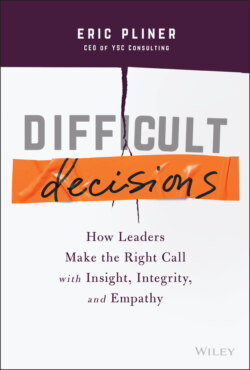Difficult Decisions

Реклама. ООО «ЛитРес», ИНН: 7719571260.
Оглавление
Eric Pliner. Difficult Decisions
Table of Contents
Guide
List of Illustrations
Pages
DIFFICULT decisions. How Leaders Make the Right Call with Insight, Integrity, and Empathy
Preface. Writing Wrong
Note
Epigraph
CHAPTER 1 Difficult Decisions
Making Difficult Decisions
How We Make Decisions Now
Difficult Decision: Containing Contagion
Key Points
Notes
CHAPTER 2 The Moral–Ethical–Role Responsibility Triangle
Morals versus Ethics: Election
Jean and Paula
Win as Much as You Can
Difficult Decision: Furloughing 80 Percent of the Ralph Lauren Workforce
Do the Right Thing
Key Points
Notes
CHAPTER 3 Morals
Communicating Your Morality and Asking about Morality
Triangle Touchpoint: Values Conflict
Knowing the Sources of Your Morality
Reflecting on the Sources of Your Morality
Understanding the Parameters and Boundaries of Your Morality
Difficult Decision: The Philip Guston Retrospective at the National Gallery of Art
A Moral Exercise
Exercise: Morality and Your Leadership Narrative
Key Points
Notes
CHAPTER 4 Ethics
Characteristics of Ethics
Ethics Are Contextually Dependent and Are, Therefore, Not Uniform
Ethics Can Change over Time
Ethics Are about Shared Social Acceptability, but They Are Not about Popularity
Difficult Decision: Hip Hop Public Health and the American Beverage Association
The Ethics of Leading Politically
Waiving Ethics
An Exercise in Exceptions
Ethics and Judgment
An Ethics Exercise
Difficult Decision: Bigger or Better? Leading for the Enterprise at Shire Pharmaceuticals
Key Points
Notes
CHAPTER 5 Role Responsibilities
Who You Are Charged to Serve
Stakeholder Mapping
Socioemotional Role
Understanding Dynamic Roles
Difficult Decision: Breaking Thrivent When It Wasn't Broken
A Role Exercise
Ask yourself:
Difficult Decision: A Hundred Years of Picasso
Key Points
Notes
CHAPTER 6 Using the Triangle to Make Difficult Decisions
Decision-Making Ecosystem and Its Associated Expectations
Thoughtful Learning and Development for the Leader
The Importance of Deep Consideration of What Truly Matters to Us
What and How to Communicate to Audiences with Varied Needs and Perspectives
The Tissue Test
Triangle Touchpoint: Brilliant Jerks
Key Points
Notes
CHAPTER 7 I Think I Know What I Think; Now What?
A Decision-Making Process
Difficult Decisions: The Best Play for Best Buy
A View, a Voice, a Vote, or a Veto
A View
A Voice
A Vote
A Veto
Delegating
Facts versus Feelings
Tools and Muscles
Key Points
Afterword
Acknowledgments
About the Author
Index
WILEY END USER LICENSE AGREEMENT
Отрывок из книги
ERIC PLINERCEO OF YSC CONSULTING
I don't mean that it's bad or evil. I mean that it's inevitably incorrect.
.....
It doesn't matter if you think these decisions are right or if anyone agrees – the whole point is that lots of people don't and won't agree. That's what makes these decisions difficult. They are subjective, and subjective decision-making is not helped by pretending to objectivity. We can't do it. We're human, we're fallible. Our lives, identities, and experiences shape the way we see the world. There's no such thing as human objectivity. So then, we want to look to science. Science, after all, can be objective. There are hard facts in the world of science. We follow the impulse to want to rely on something seemingly scientific, seemingly objective. And so we look to things like machine learning and artificial intelligence, hoping that they can somehow tell us what to do about the hard stuff, either forgetting that these technologies are themselves still created and programmed by humans (with all of our biases and fallibilities) and ignoring the fact that they still can't tell us what to do about the really hard stuff – the subjective stuff. An algorithm can give us answers – perhaps even the best answers that do the least harm – but it cannot tell us how a group of humans, each with different backgrounds and identities and experiences, will feel about those answers. And that means that perhaps it hasn't given us answers at all.
There is ample and increasing evidence that the best decisions are made by so-called centaurs3 – part human, part machine – building on the superior analytical capability (and, perhaps more importantly, speed) of technologies and the essential empathy and experience-based intuition of humans.
.....